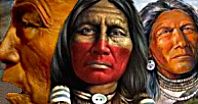|
|  |

HOHOKAM ANCIENT INDIAN CIVILIZATION

Agriculture of the Hohokam Indian
AUTHOR: Linda M. Gregonis & Karl J. Reinhard
Hohokam villagers grew cotton and corn, as well as several types of beans and squash. In the Gila and Salt River valleys, the Indians built a complex system of canals, to lead water from the rivers to their fields above the floodplain.
In contrast, the Tucson Basin people practiced floodwater farming; that is, they planted crops in the floodplains of the rivers which flooded their banks after major storms.
The rivers at that time were shallow, meandering streams; they were not deeply entrenched as they are now. The Indians probably also dug short irrigation ditches, to direct water to crops grown on the floodplain.
In parts of the basin where floodplains were not available, the Hohokam farmed at the mouths of arroyos. They also built rock terraces and check dams on hill slopes and in washes to catch rainfall runoff.
The Indian's only agricultural tools were sharp, wooden digging sticks and handheld hoes made from thin rock slabs. They may also have used broken pieces of pottery as hand shovels.
Like other North American Indians, the Hohokam probably planted their crops in a series of small earth mounds. Corn, beans, squash, and cotton could all be planted in the same mound, so that each plant provided the others with nutrients and weed protection.
Planted in March after the last winter frost, crops were ready to be harvested in July. Villagers prepared much of their harvest for use during winter and spring.
Corn was a mainstay in the Hohokam diet. Although the Indians roasted and ate corn on the cob during harvest season, they dried and ground most of the corn into flour before use.
The villagers may have made corn flour into dumplings and bread, thickened stews with it, or dropped a handful into a jar of water to make a nourishing drink.
The Hohokam ground the kernels of corn with stone tools called manos and metates. The Indians made metates from large rocks. They shaped the rocks into thick slabs or troughs, with a slightly roughened grinding surface that held kernels of corn in place during grinding.
The mano, which was held in the hand, was made from a smaller stone, also slightly roughened. In using the tools, the Indians ground the rough surfaces down; consequently, they ate small bits of rock with every meal. As a result, the teeth of most adult Hohokam were worn smooth.
Other staples in the Hohokam diet were beans and squash. Dried or parched after shelling, beans were added to stews or boiled by themselves. Squash could have been used in several ways-the blossoms boiled, the seeds parched, or strips of the fruit dried for use in winter.
Cotton was used for both food and clothing. Seeds of the plant were parched, ground, and formed into cakes. Cotton fiber was spun into yarn and then woven into ponchos, shirts, and belts.
Finished clothing and bundles of yarn may have been traded by the Hohokam to other Indians in the Southwest.
In addition to cultivated plants, the Hohokam harvested weeds that grew in their fields. Among the weeds gathered for greens and seeds were pigweed, sunflower, and tansy mustard.
SOURCE:
Excerpted from the book, 'Hohokam Indians of the Tucson Basin' by Linda M. Gregonis & Karl J. Reinhard.
Copyright © 1979.The Arizona Board of Regents
RELATED ARTICLES:
Predecesors of the Hohokam Indians
The Hohokam Indians of the Tucson Basin
Hunting and Gathering Practices of the Hohokam
Clothing and footwear of the Hohokam
Discovery of Hohokam ruins surprises archaeologists
|
 |


|
|
| | | | | | | | |
 |
|
|

